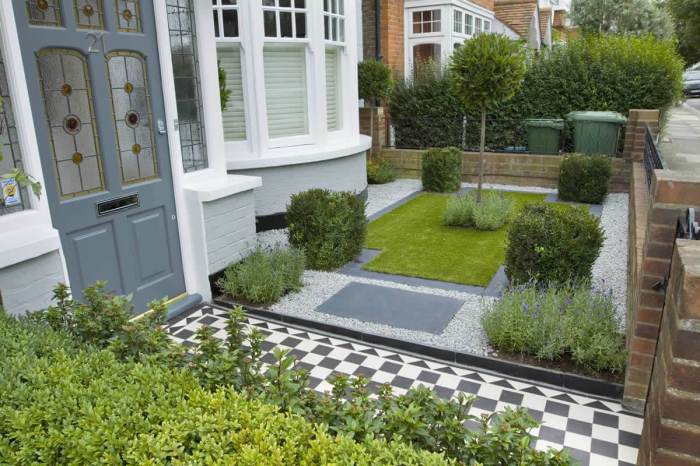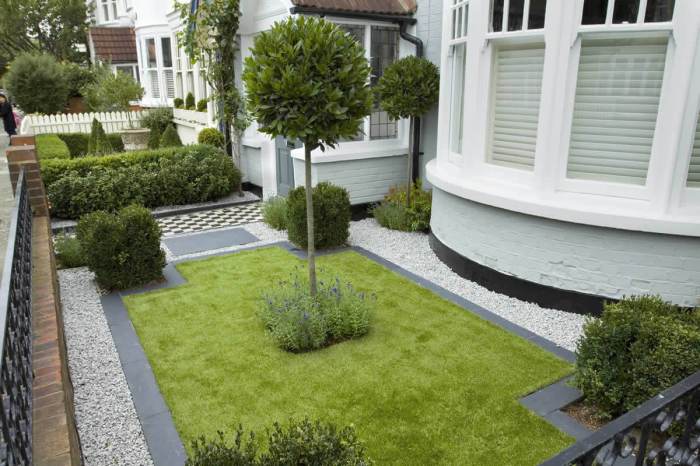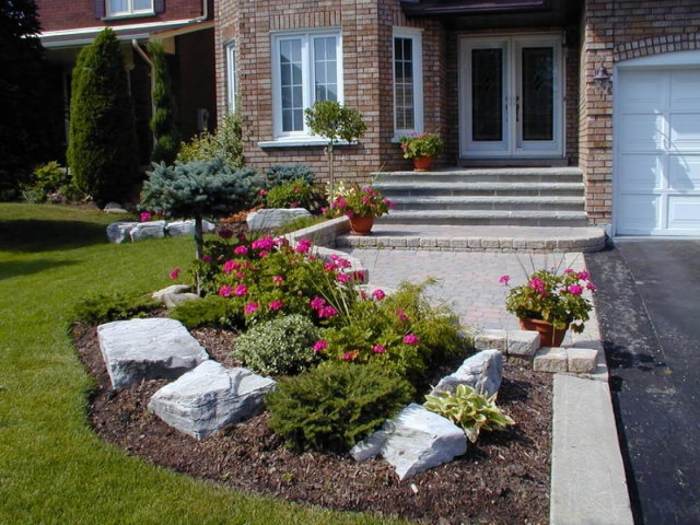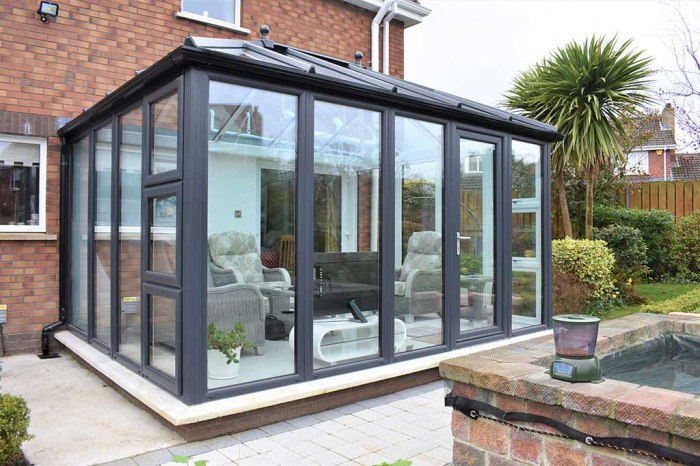Embark on a journey of inspiration as we explore new build front garden ideas, transforming your outdoor space into a captivating sanctuary. From modern design principles to sustainable practices, this guide unveils the secrets to creating a breathtaking garden that complements your home’s contemporary style.
Unleash your creativity with a comprehensive guide that covers every aspect of front garden design, empowering you to craft a landscape that reflects your taste and enhances your daily living.
Garden Design Concepts
In the realm of contemporary garden design, front gardens for new builds are embracing a fresh and innovative approach. These gardens are meticulously crafted to harmonize with the architectural style of the home, seamlessly blending indoor and outdoor living spaces.
Sustainability and functionality are paramount in modern garden design. Gardens are no longer mere aesthetic displays; they serve as functional extensions of the home, providing opportunities for relaxation, entertainment, and even food production.
Contemporary Landscaping Trends
Contemporary landscaping trends for new build front gardens include:
- Clean lines and geometric shapes, reflecting the architectural style of the home.
- Incorporation of natural elements such as stone, wood, and water features.
- Use of drought-tolerant plants and native species to promote sustainability.
- Vertical gardening techniques to maximize space and create visual interest.
- Smart irrigation systems to conserve water and optimize plant growth.
Plant Selection
Selecting the right plants for your new build front garden is crucial to create a beautiful and thriving outdoor space. Consider factors like soil type, climate, and aesthetics to make informed choices.
Suitable Plant Types
Choose a mix of plant types to add diversity and visual interest to your garden. Consider shrubs for structure and privacy, perennials for year-round blooms, and annuals for seasonal color.
Plant Placement and Spacing
Plan the placement of your plants carefully to ensure they have enough space to grow and thrive. Taller plants should be placed in the back, with shorter plants in front. Consider the spread of each plant and space them accordingly.
Specific Plant Recommendations
Here’s a list of suitable plants for new build front gardens, grouped by type:
- Shrubs:Boxwood, Hydrangea, Azalea, Rhododendron
- Perennials:Hosta, Daylily, Iris, Salvia
- Annuals:Petunia, Impatiens, Marigold, Zinnia
Hardscaping Options
Hardscaping refers to the non-living elements of a garden, such as pathways, patios, and other garden features. These elements can be made from a variety of materials, each with its own advantages and disadvantages.
When choosing hardscaping materials, it is important to consider the following factors:
- Durability:How well will the material withstand wear and tear?
- Cost:How much will it cost to install and maintain the material?
- Aesthetics:How will the material look in your garden?
- Functionality:How well will the material meet your needs?
Pathways
Pathways are an essential part of any garden, providing access to different areas and creating a sense of flow. There are a variety of materials that can be used for pathways, including:
- Concrete:Concrete is a durable and affordable option for pathways. It can be stamped or colored to create a variety of looks.
- Brick:Brick is a classic choice for pathways. It is durable and can be laid in a variety of patterns.
- Stone:Stone is a beautiful and natural option for pathways. It is durable and can be used to create a variety of looks.
- Gravel:Gravel is a budget-friendly option for pathways. It is easy to install and can be used to create a variety of looks.
Patios
Patios are a great place to relax and entertain guests. They can be made from a variety of materials, including:
- Concrete:Concrete is a durable and affordable option for patios. It can be stamped or colored to create a variety of looks.
- Brick:Brick is a classic choice for patios. It is durable and can be laid in a variety of patterns.
- Stone:Stone is a beautiful and natural option for patios. It is durable and can be used to create a variety of looks.
- Wood:Wood is a warm and inviting option for patios. It is durable and can be stained or painted to create a variety of looks.
Other Garden Features
In addition to pathways and patios, there are a variety of other hardscaping features that can be added to a garden, such as:
- Retaining walls:Retaining walls can be used to create different levels in a garden or to hold back soil.
- Fire pits:Fire pits are a great way to enjoy a warm evening in the garden.
- Water features:Water features can add a touch of tranquility to a garden.
- Sculptures:Sculptures can add a touch of personality to a garden.
Lighting Design
When designing the front garden of a new build, lighting should be a key consideration. Well-placed lights can enhance the aesthetics of your garden, create a welcoming atmosphere, and improve security. Here are some tips for choosing the right light fixtures and placement:
Light Fixture Selection
- Consider the style of your home and garden:Choose light fixtures that complement the architectural style of your home and the overall design of your garden.
- Think about the purpose of the lighting:Do you need lights for security, ambiance, or both? Different types of fixtures are better suited for different purposes.
- Choose energy-efficient fixtures:LED lights are a great option for outdoor lighting as they are energy-efficient and long-lasting.
Light Placement
The placement of your lights is just as important as the fixtures themselves. Here are a few things to keep in mind:
- Highlight architectural features:Use lights to highlight architectural features of your home, such as the front door, windows, or eaves.
- Create a welcoming path:Place lights along pathways to guide visitors safely to your front door.
- Enhance security:Install motion-activated lights around the perimeter of your property to deter intruders.
By following these tips, you can choose the right light fixtures and placement to create a beautiful and secure front garden that you and your family will enjoy for years to come.
Water Features

Water features are a wonderful way to add beauty, tranquility, and interest to your new build front garden. They can also provide a habitat for wildlife and help to improve the air quality.
There are many different types of water features to choose from, including fountains, ponds, and streams. Each type of water feature has its own unique benefits and drawbacks, so it is important to do your research before making a decision.
Fountains
- Fountains are a classic choice for water features, and they come in a wide variety of styles and sizes.
- Fountains can be made from a variety of materials, including stone, metal, and ceramic.
- Fountains are relatively easy to maintain, but they do require regular cleaning to keep them looking their best.
Ponds
- Ponds are a great way to add a touch of nature to your front garden.
- Ponds can be stocked with fish and other aquatic plants, and they can provide a habitat for wildlife.
- Ponds require more maintenance than fountains, but they can be a beautiful and rewarding addition to your garden.
Streams, New build front garden ideas
- Streams are a great way to add a sense of movement and dynamism to your front garden.
- Streams can be created using a variety of materials, including rocks, pebbles, and concrete.
- Streams require more maintenance than fountains or ponds, but they can be a beautiful and unique addition to your garden.
No matter what type of water feature you choose, it is important to make sure that it is properly maintained. This includes cleaning the water regularly, checking the equipment, and making sure that the water feature is not a hazard to children or pets.
Seating and Outdoor Living: New Build Front Garden Ideas

Creating comfortable and inviting seating areas is essential for enjoying your new build front garden. Choose outdoor furniture that is weather-resistant and complements the style of your home. Consider adding cushions and throws for extra comfort.
Furniture and Accessories
Select outdoor furniture that is both stylish and functional. Choose pieces that are comfortable to sit on and easy to maintain. Consider the size of your space and the number of people you want to accommodate. Add accessories such as cushions, throws, and lanterns to create a cozy and inviting atmosphere.
Shade and Shelter
Provide shade and shelter from the sun and rain to make your seating area more comfortable. Install a pergola, awning, or umbrella. You can also plant trees or shrubs to create natural shade.
Privacy and Screening

Enhance privacy and seclusion in new build front gardens with clever screening solutions. Fences, hedges, and other materials create a sense of enclosure, shielding your outdoor haven from prying eyes and unwanted intrusions.
Fencing Options
Fences offer instant privacy and define property boundaries. Consider solid wood fences for complete visual obstruction, or slatted or lattice fences for a more airy and light-filtering effect. Opt for natural materials like timber or bamboo for a rustic touch, or sleek metal or composite materials for a modern aesthetic.
Hedge Varieties
Hedges provide a lush, living screen that can grow to substantial heights. Evergreen hedges like boxwood, holly, or yew offer year-round privacy, while deciduous hedges like privet or hawthorn offer seasonal screening. Choose fast-growing varieties for quicker results and consider double rows for increased density.
Screening Materials
Beyond fences and hedges, various materials can enhance privacy and screening. Trellises with climbing plants, bamboo screens, or fabric panels can create a vertical green wall that both conceals and adds aesthetic appeal. Alternatively, use outdoor curtains or blinds for a more temporary and adjustable screening solution.
Sustainability
Sustainability is a crucial aspect of modern front garden design. By incorporating eco-friendly practices, we can minimize environmental impact and create gardens that are both beautiful and responsible.
Choosing Eco-Friendly Materials
Opt for materials like recycled plastic, reclaimed wood, and natural stone that have a lower carbon footprint. Consider permeable paving options to reduce stormwater runoff and promote groundwater recharge.
Selecting Native Plants
Native plants are adapted to the local climate and require less water, fertilizer, and pesticides. They also support local wildlife and promote biodiversity. Choose plants that attract pollinators and beneficial insects to enhance the ecosystem.
Reducing Water Consumption
Install a rainwater harvesting system to collect and store rainwater for irrigation. Use drought-tolerant plants that require minimal watering. Consider xeriscaping techniques, such as using gravel or mulch to conserve moisture.
Minimizing Environmental Impact
Avoid using harmful chemicals like pesticides and fertilizers. Practice organic gardening methods to promote soil health and reduce pollution. Choose low-maintenance plants that require less labor and resources to maintain.
Cost Considerations
Creating a beautiful front garden for your new build doesn’t have to break the bank. With careful planning and smart choices, you can create a stunning outdoor space that fits your budget. Here’s a breakdown of the potential costs and factors to consider:
The cost of a new build front garden can vary depending on several factors, including the size of the garden, the materials used, the complexity of the design, and the cost of labor in your area. The following are some of the major cost considerations:
Materials
The materials you choose for your garden will have a significant impact on the cost. Natural materials like stone, wood, and plants are generally more expensive than synthetic materials like plastic and concrete. However, natural materials are often more durable and can add value to your home in the long run.
Labor
The cost of labor will vary depending on the complexity of the design and the availability of skilled workers in your area. If you are planning a complex garden with a lot of custom features, you can expect to pay more for labor.
Design Complexity
The more complex the design of your garden, the more it will cost to build. Simple gardens with clean lines and minimal features are generally less expensive than gardens with complex curves, multiple levels, and a lot of custom details.
Maintenance and Care

Regular maintenance is crucial for a thriving new build front garden. It ensures the health and beauty of your plants, extends the life of hardscaping elements, and maintains a clean and inviting outdoor space.
Watering Schedule
Establish a consistent watering schedule, considering your plant selection, soil type, and weather conditions. Adjust the frequency and duration based on the season, rainfall, and plant water requirements.
Fertilization
Fertilize your plants according to their specific needs. Use a balanced fertilizer and follow the manufacturer’s instructions. Regular fertilization provides essential nutrients for healthy growth and blooming.
Other Essential Tasks
-
-*Pruning
Remove dead or overgrown branches, shape plants, and encourage new growth.
-*Weed Control
Regularly remove weeds to prevent competition for water and nutrients.
-*Mulching
Spread mulch around plants to retain moisture, suppress weeds, and regulate soil temperature.
-*Pest and Disease Management
Monitor your plants for pests and diseases. Treat promptly to prevent spread and damage.
Potential Challenges
-
-*Drought
Monitor soil moisture levels and water deeply during dry spells.
-*Overwatering
Avoid overwatering, as it can lead to root rot and other problems.
-*Pest and Disease Infestations
Be vigilant for signs of pests and diseases. Act quickly to prevent spread.
-*Maintenance Costs
Factor in the ongoing costs of watering, fertilizing, and other maintenance tasks.
By following a regular maintenance schedule and addressing potential challenges promptly, you can keep your new build front garden looking its best for years to come.
Last Point
As you delve into these new build front garden ideas, remember that your garden is a canvas upon which you can paint your dreams. Embrace sustainability, functionality, and aesthetics to create a space that not only beautifies your home but also nourishes your soul.
Let your garden be a sanctuary where you can relax, rejuvenate, and connect with nature.
Key Questions Answered
What are the key principles of modern garden design?
Modern garden design emphasizes clean lines, simplicity, and functionality. It incorporates natural elements, sustainable practices, and a focus on creating outdoor living spaces that seamlessly blend with the home’s architecture.
How can I choose the right plants for my new build front garden?
Consider factors such as soil type, climate, and aesthetics when selecting plants. A mix of shrubs, perennials, and annuals can provide year-round interest and create a dynamic landscape.
What are some creative hardscaping options for front gardens?
Explore materials like natural stone, concrete pavers, and wooden decking to create pathways, patios, and other features. Consider incorporating geometric shapes, patterns, and lighting to enhance the visual appeal.


